Few things get foragers more excited than morel season—it’s like Christmas for mushroom enthusiasts. And yes, I’m definitely one of them. These wrinkly little mushrooms are pure gold for anyone who loves fungi. They’re packed with flavor, nearly impossible to cultivate, and you won’t find them in your average grocery store. That kind of rarity only makes hunting them even more rewarding.
As a hobbyist mycologist, I get genuinely thrilled when the cottonwood trees start budding. It’s my personal signal that spring has arrived—and that it’s time to head into the hills and indulge my mushroom-gathering habit.
If you’re ready to get outside and fill your skillet with something wild, I’ve put together the essential tips, tricks, and knowledge you need to start your search for these elusive, edible fungi.
DISCLAIMER: Foraging for wild plants and mushrooms can be dangerous. Only consume what you can confidently identify. If you’re unsure, don’t eat it. Seek out local experts to help confirm your finds—mistakes could be life-threatening.
What’s the Hype With Morel Mushrooms?
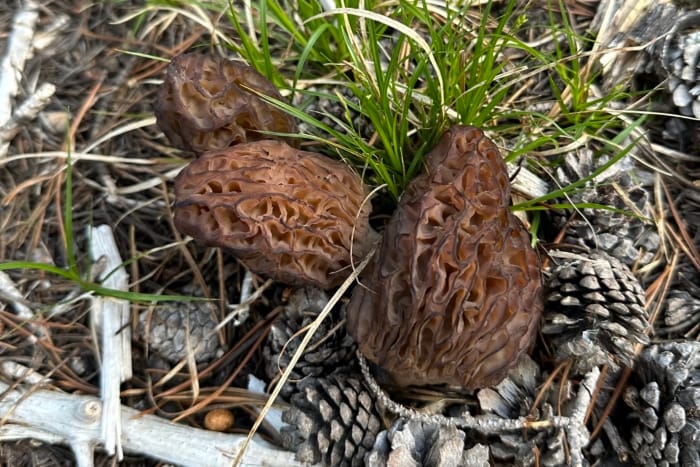
Morel mushrooms are among the most highly prized mushrooms in the world.
Depending on where you live and the season, they can sell for as much as $50 per pound. Why? Because they’re incredibly flavorful and nearly impossible to grow commercially. That means if you want to enjoy these culinary treasures, you either need to open your wallet—or hit the trails and hunt them yourself.
A Culinary Marvel
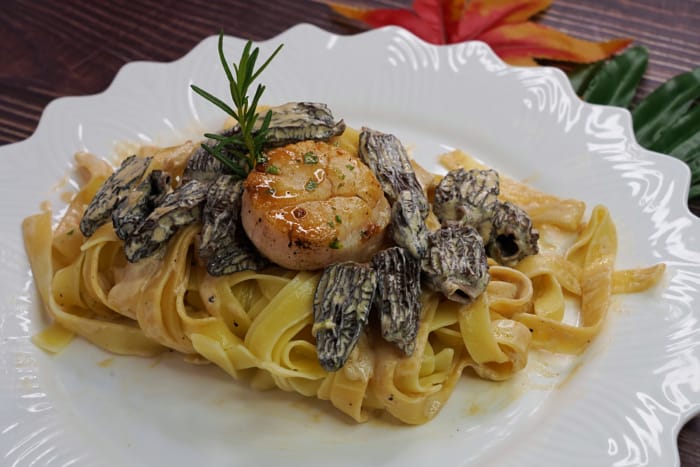
Morel mushrooms have a pleasantly meaty texture, making them a great meat substitute in many dishes. Unlike other mushrooms, they don’t have the slimy feel that sometimes turns people off. Their flavor is subtly nutty—light and delicate, never overpowering.
I like to call morels a “gateway mushroom” for anyone who’s usually not a fan of fungi. They have a way of converting even the most skeptical eaters into devoted mushroom lovers.
During morel season, I find myself adding them to almost every meal. It’s hard to think of a dish that doesn’t benefit from their addition. From a simple breakfast omelet to a gourmet dinner, morels are versatile, elevating each meal they touch—and truly excelling at it.
Types of Morel Mushrooms

In North America, there are currently 18 known species of morels, though most foragers tend to identify them by color. Black, white, and yellow are the most common, but some people also recognize green and gray varieties. The good news? As long as they’re cooked properly, all morels are edible.
Identifying Morel Mushrooms
Mushrooms may be delicious, but they can also be dangerous. If you’re thinking about foraging, it’s essential to learn what you’re doing. One wrong pick can have serious, even life-threatening consequences.
The woods are full of toxic lookalikes that can cause real harm. Depending on the species, eating the wrong mushroom could lead to an upset stomach, severe diarrhea, vivid hallucinations, or worse. This is not something to take lightly. Always make absolutely sure you know what you’re picking before it goes into your basket—your health, and your life, depend on it.
NOT Morels
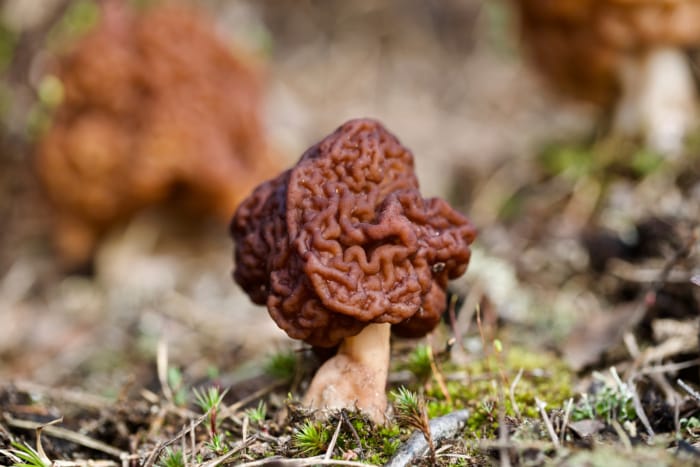
Morels do have a few lookalikes, but once you know what to look for, spotting the difference is pretty straightforward. False morels typically have wrinkled, irregular caps and stems that are solid or only partially hollow. True morels, by contrast, have deeply pitted caps and are completely hollow from top to bottom.
Some sources say certain false morels can be eaten if prepared very carefully. Personally, I don’t think the risk is worth it—and from what I’ve heard, they’re not particularly tasty anyway.
False Morel Red Flags
- Not completely hollow, fleshy interior
- Wrinkled, brain-like cap, not pitted
- Cap disconnected from stem or only connected at the top of the stem
- More red, purple, brown colored
- Irregular, “smooshed” shape
Morel Mushrooms Identification
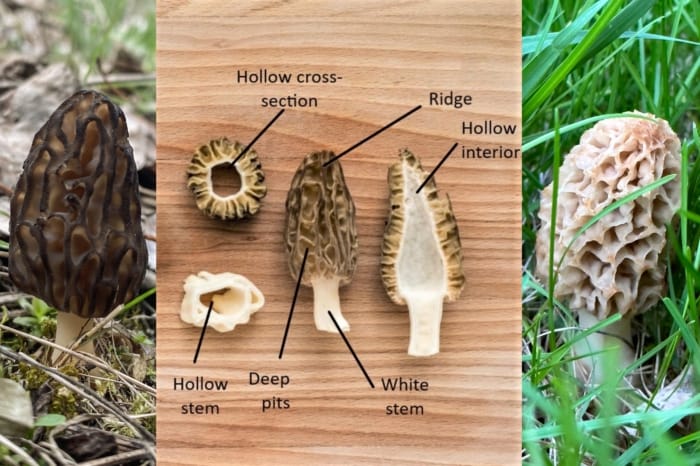
One of the easiest ways to tell a true morel from its lookalikes is by checking for hollowness. If you slice a morel from top to bottom—or take a cross-section—you’ll see that it’s hollow all the way through, from the tip of the cap down to the stem.
True morels also have deep, well-defined pits, which are perfect for soaking up butter when cooking. Their caps usually taper to a point, giving them a peaked shape. False morels, on the other hand, often look squished and grow in irregular, brain-like patterns.
Morel Mushroom Green Flags
- Hollow-bodied from stem to cap
- Deeply pitted cap, not wrinkled
- Fully connected stem and cap (in most cases)
- Colors ranging from black, gray, tan, yellow, and whitish
- Pointed, peaked growth
How to Find Morel Mushrooms
Now let’s cover the basics you’ll need to start your morel hunt. From the right tools to the best locations, timing, and a few helpful tips and tricks, we’ll guide you through everything you need to kick off your mushroom foraging adventure.
Tools Needed
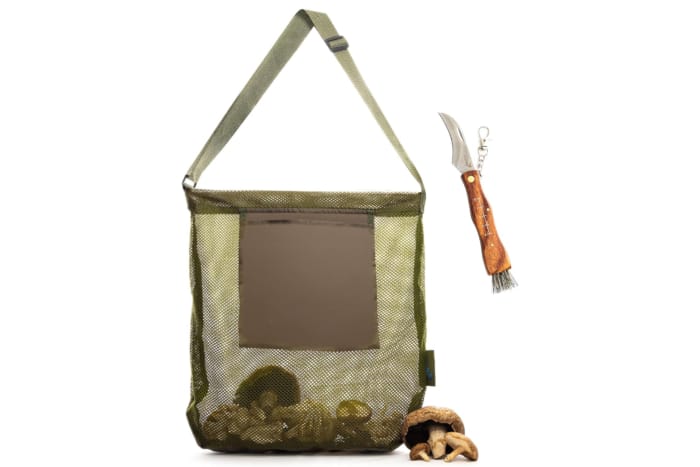
Technically, you don’t need any tools to forage for mushrooms—you can just pop them out of the ground and toss them in a bag. That said, morels are delicate, and harvesting them carefully can help ensure bigger future yields (or so the experts say). If you want to take your foraging a bit more seriously, two simple tools can make a big difference.
Mushroom knife: These specialty knives are designed for harvesting mushrooms. They usually have a curved blade that lets you hook the stem just above the soil, leaving a small “stem stubble” behind and protecting the mycelium below. Some, like the Opinel No. 08 Mushroom Knife, even have a brush on the handle for cleaning off dirt and debris.
Mushroom bag: A vented or mesh mushroom bag helps keep your mushrooms fresh and protected. Morels are fragile—their hollow bodies and crumbly stems can break easily. Reusable produce bags work well too, and a net-like bag has the added benefit of spreading spores as you walk, helping more mushrooms grow in the future. Of course, a simple plastic grocery bag works in a pinch.
If you want to save time and have everything in one place, an All-in-One Mushroom Foraging Kit, like the one pictured above, is a great option.
When to Look

Morels have a very short and highly anticipated season—spring is the time to hunt. A good rule of thumb is to start looking as soon as the leaves on deciduous trees in your area begin to bud.
In the U.S., morels are most commonly found from March through June, though elevation plays a big role in when they appear. Higher elevations usually see mushrooms pop later than lowlands or coastal areas.
Luckily, there are plenty of resources online to help you pinpoint the best spots in your region. One of the most helpful is the Morel Mushroom Sightings Map, which tracks when and where people are finding their first morels each season. Typically, sightings start along the coasts, then move through low-elevation central areas, and finally appear in mountain regions.
Where to Find Morel Mushrooms
Once the season hits in your area, there are some key places and signs to look for when hunting morels—but take it with a grain of salt.
I’ve personally found morels right next to rest stop parking lots, and even while shooting my bow in my own yard. These mushrooms are mysterious and unpredictable—they often show up where you least expect them and skip the spots you’d think they’d favor.
Moisture
Like most mushrooms, morels appreciate some moisture—but they actually prefer it a bit drier than you might expect. Look for shady spots under trees that aren’t soaking wet but have a little residual dampness from being shaded throughout the day. You’re more likely to find morels there than along riverbanks or near standing water.
Trees
Trees are a key clue when hunting for morels. Oak, elm, ash, and aspen are prime targets, though morels can sometimes grow at the base of other tree species as well.
Morels and trees share a mycorrhizal relationship, which means they help each other thrive. The mushrooms provide extra moisture to the tree roots, while the trees supply nutrients like sugars that the morels need to grow. That’s why you’ll almost always find morels in wooded areas rather than out in open fields.
Fire
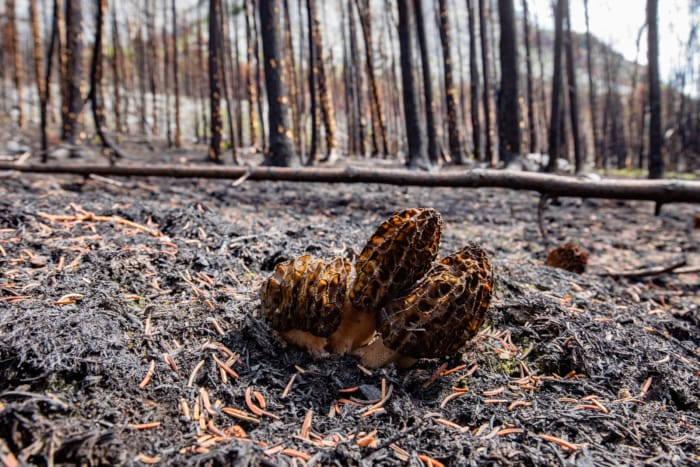
Morels have a special affinity for burn areas. “Burn morels” are the mushrooms that appear after a fire has swept through a forest. These varieties are often hardier than other morels, and the heat from the fire actually triggers them to fruit.
The mycelium of a burn morel specifically attaches to conifer trees and stays dormant until a fire passes through. Once the ground has cooled after the blaze, these morels can appear in incredible numbers—and they often continue to produce for several seasons following the burn.
Preparing Morel Mushrooms
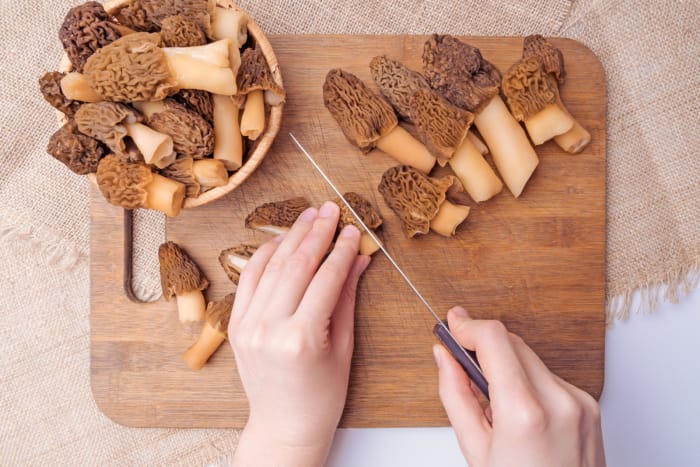
The most important rule when it comes to eating the morels you forage? Cook them thoroughly. There have been a few deaths linked to undercooked morel mushrooms, though the exact cause isn’t fully understood. The bottom line: cook your morels.
Because of where morels grow, they often come home covered in soil and debris. Rather than washing them with water, it’s best to use a soft brush—like the one on a mushroom knife—to clean off any dirt.
Once they’re cleaned, the culinary possibilities are endless. You can sauté them in butter, top a pizza, toss them into your morning omelet, stir them into spaghetti sauces, or make a rich morel cream sauce—which is my personal favorite.
If you happen to harvest more than you can eat fresh, drying them is a great option. Slice them in half to help them dry thoroughly, then use a dehydrator. Dried morels store well and can be rehydrated for use throughout the year, though they’re always best fresh when possible.
So grab your knife, hit the woods, forage carefully, and enjoy the taste of spring—one delicious morel at a time.
FAQ’s
What is the easiest way to find morel mushrooms?
Look in moist forests, near dead or dying trees, and after a good spring rain. Experienced hunters also check old orchards, riverbanks, and areas that warmed up quickly in spring.
Why are morel mushrooms so hard to find?
Morels grow in very specific conditions and only for a short window each year. Their camouflage in leaf litter and their patchy growth patterns make them tricky to spot.
What is the best time of day to find morels?
Early morning is ideal. The ground is still moist from dew, making morels easier to spot and less likely to have been picked by others.
What are the best conditions to look for morels?
Warm days (60–70°F) after spring rain, moist soil, and shaded areas are best. Avoid overly dry or frozen ground.
What kind of trees do morels grow around?
Morels often grow near ash, elm, apple, maple, poplar, and oak trees, especially dead or dying ones. Old orchards are particularly productive.
Where do most morel mushrooms grow?
They’re common in North American forests, especially in the Midwest, the Great Lakes region, and parts of the Pacific Northwest.
What is the best elevation for morels?
Low to mid-elevation areas usually produce more mushrooms. Avoid high mountain zones that stay cold late into spring.
Where can I look for morels near me?
Check local forests, parks (with permission), riverbanks, and old orchards. Local mushroom hunting clubs or online forums often have tips on nearby hotspots.
What is the best climate for morel mushrooms?
Cool, moist spring climates are ideal. They appear after soil warms to around 50–60°F following rainfall.
What is the best state for morel mushroom hunting?
States like Michigan, Wisconsin, Missouri, and Indiana are famous for morels, but they grow in most temperate states.
What does a false morel look like?
False morels often have wrinkled, lobed, or brain-like caps. They can be reddish-brown and sometimes hollow, but the interior is irregular or chambered, unlike true morels.
How can I be 100% sure it’s a true morel?
Cut the mushroom in half vertically. A true morel is completely hollow from stem to cap. Also, the cap is attached directly to the stem, not hanging loosely.
Can you eat morel mushroom stems?
Yes, the stems are edible. Just clean them well and cook them properly.
How to tell the difference between a false morel and a real morel?
True morels are fully hollow inside and have a honeycomb cap attached to the stem. False morels are often chambered, irregular, or wrinkled. Cooking does **not** make false morels safe.
How long to soak morels in salt water?
Soak for about 20–30 minutes to remove dirt and insects, then rinse thoroughly before cooking.
Where are false morels found?
False morels grow in similar habitats to true morels, often under conifers, near dead trees, or in sandy soils. They can be found across North America.
Is beefsteak morel the same as false morels?
Yes, the beefsteak morel (Gyromitra spp.) is considered a type of false morel and is toxic if not prepared correctly.
What is the difference between a half free morel and a true morel?
Half-free morels have caps attached partway down the stem, while true morels have caps fully attached at the base. Both are edible if identified correctly.
What is another name for the false morel mushroom?
False morels are also called *Gyromitra*, *beefsteak mushrooms*, or *brain mushrooms*.
When to not eat morels?
Never eat raw morels, old or moldy mushrooms, or anything that resembles a false morel. Also avoid eating morels with unknown identification.
What is the best time to hunt morels?
Spring, typically from late March to early June, depending on your region and local weather.
What happens if you don’t cook morels?
Raw morels can cause nausea, stomach upset, or mild toxicity. Cooking neutralizes these compounds and makes them safe to eat.
Do you have to cook morels before eating?
Yes. Frying, sautéing, or boiling ensures they’re safe and improves flavor.
What is the life cycle of a morel?
Morels grow from spores underground in mycelium form. When conditions are right in spring, the fruiting body emerges above ground, matures quickly, and releases spores.
How to store morels?
Fresh morels can be kept in a paper bag in the fridge for a few days. They can also be dried or frozen for longer storage.
What are the symptoms of morel poisoning?
Eating false morels or raw morels can cause nausea, vomiting, diarrhea, dizziness, and in severe cases, liver damage. Seek medical attention if symptoms occur.
Should I rinse morels?
Yes, rinse briefly or soak for 20–30 minutes to remove dirt and insects. Avoid soaking too long or they’ll absorb water.
Are morels good for your brain?
Morels contain antioxidants, vitamins, and minerals, which can support overall health, including brain function, but they’re not a miracle food.
What is toxic in morels?
Raw morels contain small amounts of hydrazine compounds, which are neutralized by cooking. False morels contain gyromitrin, a highly toxic compound.
What’s the most poisonous mushroom?
The *Amanita phalloides*, or death cap, is considered the most poisonous mushroom in the world.
How to tell if morels went bad?
Signs include a slimy texture, dark spots, foul smell, or mold. If any of these appear, discard the mushrooms.
